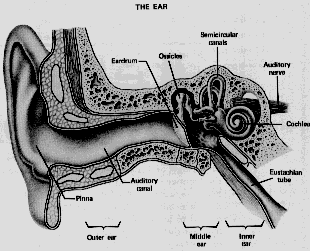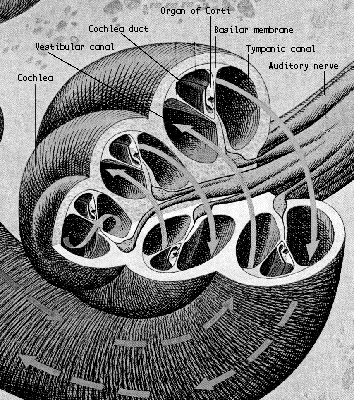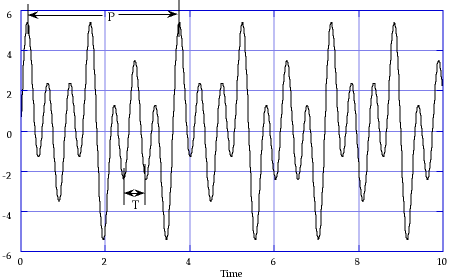Basic Facts Week 4
Ear Physiology
The Ear: Sound is is gathered for the ear by the outer flap, the pinna, and directed down the auditory canal. At the end of the canal is the thin membrane of the eardrum. Sound waves travel down the ear canal and set up vibrations in the eardrum. All the structures up to the eardrum make up the outer ear.

The next region of the ear, the middle ear, contains a set of three bones, the hammer (malleus), the anvil (incus), and the stirrup (stapes) that together make upa level system that magnifies the force of the ear drum by a factor of three. Thus the eardrum moves further than the stirrup but the stirrup pushes three times as hard. The stirrup pushes on the oval window that leads into the inner ear. There is a small tube, the eustachian tube, that connects the middle ear to the inside of the nose. It keeps the average pressure in the middle ear the same as the average pressure in the outer ear. When it becomes blocked by a cold or allergies your ears hurt when you experience changes in air pressure such as occur in aeroplanes or when going up and down mountains.

The final region of the ear, the inner ear, contains two structures. The semi-circular canals allow the brain to sense orientation and motion and are vital to our sense of balance. The cochlea is the actual organ of hearing.

The stirrup bone transmits sound to the oval window where it sets up vibrations in the fluid filled cochlea. These vibrations cause regions of the basilar membrane to vibrate in sympathy and motions of that membrane stimulate nerve cells called hair cells in the organ of Corti to inform the brain about the sound. Different positions along the basilar membrane respond to different frequencies of sound and give us our sensations of pitch and timbre as different groups of hair cells are stimulated.
The average ear responds to pure tones (sine waves) over a frequency range from about 20Hz to as much as 20,000Hz (20kHz). As we age the higher limit of audibility falls and the effect is more pronounced in men than in women.
The ear can detect differences in pitch of about 1Hz over a range up to about 2000Hz, the entire range of orchestral pitches. Above 2kHz the just noticeable difference (JND) increases steadily.
The ear responds non-linearly to sound intensity. It is much more sensitive to changes in sound level at low levels of sound than at high levels. On average a ten fold increase in the intensity of a sound makes the sound twice as loud. The ear is much less sensitive to low frequencies than to high frequencies and the effect is particularly pronounced for quiet sounds.
Aural Perception
Pitch. In order for a sound to have a clearly defined pitch the waveform must be periodic. The frequency of the sound is perceived as 1/period. In the figure below the ear hears the sound as having the pitch 1/P not 1/T or any other sub period.

Fourier's Theory states that any periodic wave of period P may be built from a set of sine waves whose frequencies form a harmonic series with fundamental frequency f0 = 1/P. Each sine wave must be chosen with exactly the right frequency and phase and the theory provides a mathematical way to find the correct values from the shape of the complex wave.
We call building a complex wave from a set of sine waves Fourier Synthesis and the reverse process is called Fourier Analysis. We call a plot of the Fourier Analysis of a complex wave the Spectrum of the wave.
The timbre of a note is the distinctive color of the sound. It depends in large part on the spectrum of the waveform. The more high frequency components the spectrum has the brighter or tinnier the sound is. Dull sounds have spectra with few high frequency components. The timbre is also affected by the envelope of the sound, the pattern of loudness as a function of time, and by the way that the spectrum changes during the note.
